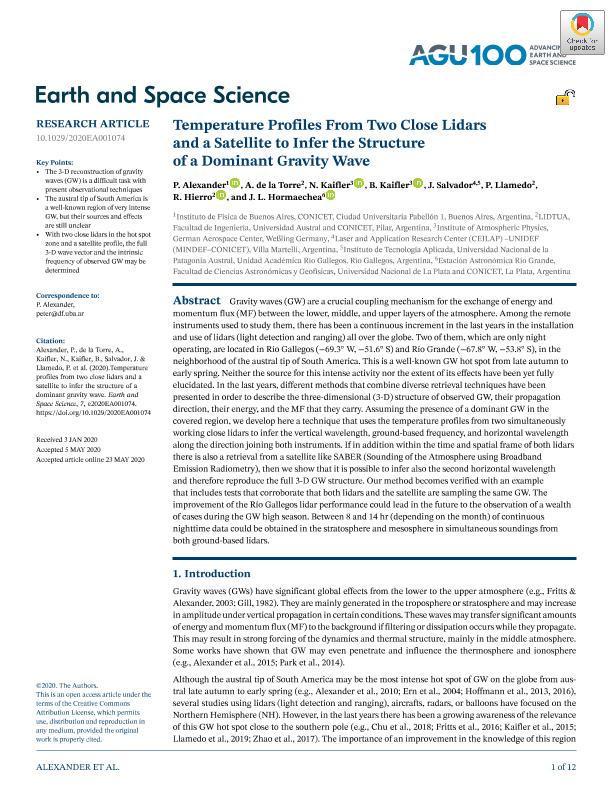Mostrar el registro sencillo del ítem
dc.contributor.author
Alexander, Pedro Manfredo

dc.contributor.author
de la Torre, Alejandro

dc.contributor.author
Kaifler, Natalie

dc.contributor.author
Kaifler, B.
dc.contributor.author
Salvador, Jacobo Omar

dc.contributor.author
Llamedo Soria, Pablo Martin

dc.contributor.author
Hierro, Rodrigo Federico

dc.contributor.author
Hormaechea, José Luis

dc.date.available
2022-09-22T14:36:08Z
dc.date.issued
2020-07
dc.identifier.citation
Alexander, Pedro Manfredo; de la Torre, Alejandro; Kaifler, Natalie; Kaifler, B.; Salvador, Jacobo Omar; et al.; Temperature Profiles From Two Close Lidars and a Satellite to Infer the Structure of a Dominant Gravity Wave; John Wiley & Sons Inc.; Earth and Space Science; 7; 7; 7-2020; 1-12
dc.identifier.uri
http://hdl.handle.net/11336/169977
dc.description.abstract
Gravity waves (GW) are a crucial coupling mechanism for the exchange of energy and momentum flux (MF) between the lower, middle, and upper layers of the atmosphere. Among the remote instruments used to study them, there has been a continuous increment in the last years in the installation and use of lidars (light detection and ranging) all over the globe. Two of them, which are only night operating, are located in Río Gallegos (−69.3° W, −51.6° S) and Río Grande (−67.8° W, −53.8° S), in the neighborhood of the austral tip of South America. This is a well-known GW hot spot from late autumn to early spring. Neither the source for this intense activity nor the extent of its effects have been yet fully elucidated. In the last years, different methods that combine diverse retrieval techniques have been presented in order to describe the three-dimensional (3-D) structure of observed GW, their propagation direction, their energy, and the MF that they carry. Assuming the presence of a dominant GW in the covered region, we develop here a technique that uses the temperature profiles from two simultaneously working close lidars to infer the vertical wavelength, ground-based frequency, and horizontal wavelength along the direction joining both instruments. If in addition within the time and spatial frame of both lidars there is also a retrieval from a satellite like SABER (Sounding of the Atmosphere using Broadband Emission Radiometry), then we show that it is possible to infer also the second horizontal wavelength and therefore reproduce the full 3-D GW structure. Our method becomes verified with an example that includes tests that corroborate that both lidars and the satellite are sampling the same GW. The improvement of the Río Gallegos lidar performance could lead in the future to the observation of a wealth of cases during the GW high season. Between 8 and 14 hr (depending on the month) of continuous nighttime data could be obtained in the stratosphere and mesosphere in simultaneous soundings from both ground-based lidars.
dc.format
application/pdf
dc.language.iso
eng
dc.publisher
John Wiley & Sons Inc.

dc.rights
info:eu-repo/semantics/openAccess
dc.rights.uri
https://creativecommons.org/licenses/by/2.5/ar/
dc.subject
GRAVITY WAVES
dc.subject
LIDAR
dc.subject
SOUTHERN PATAGONIA
dc.subject.classification
Meteorología y Ciencias Atmosféricas

dc.subject.classification
Ciencias de la Tierra y relacionadas con el Medio Ambiente

dc.subject.classification
CIENCIAS NATURALES Y EXACTAS

dc.title
Temperature Profiles From Two Close Lidars and a Satellite to Infer the Structure of a Dominant Gravity Wave
dc.type
info:eu-repo/semantics/article
dc.type
info:ar-repo/semantics/artículo
dc.type
info:eu-repo/semantics/publishedVersion
dc.date.updated
2022-09-19T15:08:26Z
dc.identifier.eissn
2333-5084
dc.journal.volume
7
dc.journal.number
7
dc.journal.pagination
1-12
dc.journal.pais
Estados Unidos

dc.journal.ciudad
Nueva York
dc.description.fil
Fil: Alexander, Pedro Manfredo. Consejo Nacional de Investigaciones Científicas y Técnicas. Oficina de Coordinación Administrativa Ciudad Universitaria. Instituto de Física de Buenos Aires. Universidad de Buenos Aires. Facultad de Ciencias Exactas y Naturales. Instituto de Física de Buenos Aires; Argentina
dc.description.fil
Fil: de la Torre, Alejandro. Consejo Nacional de Investigaciones Científicas y Técnicas; Argentina. Universidad Austral. Facultad de Ingeniería. Departamento de Ciencias Básicas; Argentina
dc.description.fil
Fil: Kaifler, Natalie. German Aerospace Center; Alemania
dc.description.fil
Fil: Kaifler, B.. German Aerospace Center; Alemania
dc.description.fil
Fil: Salvador, Jacobo Omar. Consejo Nacional de Investigaciones Científicas y Técnicas. Instituto de Investigaciones Científicas y Técnicas para la Defensa. Centro de Investigación en Láseres y Aplicaciones; Argentina. Universidad Nacional de la Patagonia Austral. Unidad Académica Río Gallegos; Argentina
dc.description.fil
Fil: Llamedo Soria, Pablo Martin. Consejo Nacional de Investigaciones Científicas y Técnicas; Argentina. Universidad Austral. Facultad de Ingeniería. Departamento de Ciencias Básicas; Argentina
dc.description.fil
Fil: Hierro, Rodrigo Federico. Consejo Nacional de Investigaciones Científicas y Técnicas; Argentina. Universidad Austral. Facultad de Ingeniería. Departamento de Ciencias Básicas; Argentina
dc.description.fil
Fil: Hormaechea, José Luis. Consejo Nacional de Investigaciones Científicas y Técnicas; Argentina. Universidad Nacional de La Plata. Facultad de Ciencias Astronómicas y Geofísicas; Argentina
dc.journal.title
Earth and Space Science
dc.relation.alternativeid
info:eu-repo/semantics/altIdentifier/url/https://onlinelibrary.wiley.com/doi/abs/10.1029/2020EA001074
dc.relation.alternativeid
info:eu-repo/semantics/altIdentifier/doi/http://dx.doi.org/10.1029/2020EA001074
Archivos asociados
